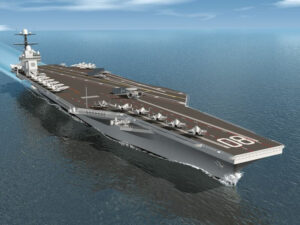The president and CEO of shipbuilder HII [HII] on Thursday confirmed supply chain issues are the primary reason why the Navy said delivery of the future USS Enterprise
(CVN-80) aircraft carrier is being delayed at least a year and a half, but the next ship is still projected on time.
“Enterprise is the supply chain. Fundamentally, we’ve got some late material at the bottom of the ship that we can’t erect it, we can’t erect the ship until we get it done,” HII CEO and President Chris Kastner told reporters Thursday.

He added that the shipbuilders have “done some pretty heroic stuff to keep [the future USS Doris Miller (CVN-81)] on schedule,” because the company will not only be resequencing aspects of ship construction, but also building two carriers at the dock at the same time.
Kastner said that simultaneous shipbuilding is not unprecedented, “we can do that from time to time, but this was a Navy and Newport News developed approach to mitigate the impact on 81.”
The Navy’s fiscal year 2025 budget request documents said the service projected delivery of CVN-80 to be in September 2029, a delay compared to the FY ‘24 documents that projected March 2028 (Defense Daily, March 18).
The documents said CVN-80’s delay was due to problems with material availability and industry/supply chain performance.
During a November 2023 earnings call, Kastner said CVN-80 was behind a year due to delays of major components related to effects from post-COVID-19 pandemic labor and supply chain impacts (Defense Daily, Nov. 2, 2023).
However, the Secretary of the Navy’s 45-day shipbuilding review, unveiled this week, showed the Navy thinks the Enterprise is now running 18 to 26 months late (Defense Daily, April 3).
During a media roundtable for the shipbuilding review, Commander of Naval Sea Systems Command Vice Adm. James Downey said CVN-80 delays were caused by key supplier issues.
“That is actually impacting several of our programs. So we’ve been focused on those areas. And, yes, there’s been some continued slippage across several programs beyond Columbia. So that’s our major issue there on the movement to 18 to 26 months.”
Downey also said CVN-81 is protected from these delays due to the two-carrier contract that allowed HII to order materials early.
He said between CVN-81’s parts ordered in the two-carrier buy and the work the Navy and HII have done to enable building almost two carriers at once, “we can actually build two CVNs, or a CVN and two thirds or so as we launched one and you continue with the other, which was a joint investment between Navy and Newport News, so we don’t see a schedule impact on 81 from where we are at this point.”
Downey also underscored the dry dock approach is on track and with implementation, and it looks like CVN-80s’ schedule will not be delayed any further while CVN-81 stays on track.